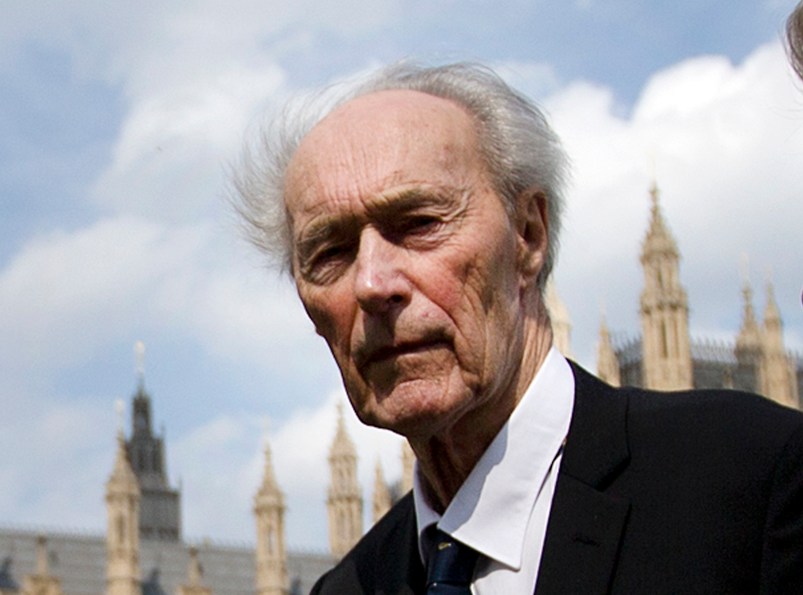COPENHAGEN, Denmark (AP) — Norway on Monday mourned World War II saboteur Joachim Roenneberg, who headed a five-man team that daringly blew up a plant producing heavy water, depriving Nazi Germany of a key ingredient it could have used to make nuclear weapons.
Prime Minister Erna Solberg said Roenneberg, who died Sunday at 99, was “one of our finest resistance fighters” whose “courage contributed to what has been referred to as the most successful sabotage campaign” in Norway.
Roenneberg, then 23, was tapped by the Special Operations Executive, or SOE — Britain’s war-time intelligence gathering and sabotage unit — to destroy key parts of the heavily guarded plant in Telemark, in southern Norway, in a raid in February 1943.
In a 2014 Norwegian documentary in connection with his 95th birthday, Roenneberg said the daring operation went “like a dream” — a reference to the fact that not a single shot was fired.
Parachuting onto snow-covered mountains, the group was joined by a handful of other commando soldiers before skiing to their destination. They then penetrated the fortress-like heavy-water plant to blow up its production line.
Roenneberg said he made a last-minute decision to cut the length of his fuse from several minutes to seconds, ensuring that the explosion would take place but making it more difficult to escape. The group skied hundreds of kilometers (miles) across the mountains to escape and Roenneberg, wearing a British uniform, ended up in neighboring neutral Sweden.
Operation Gunnerside has been recounted in books, documentaries, films and TV series, including “The Heroes of Telemark,” starring Kirk Douglas and Richard Harris.
“We must not forget what he stood for and has passed on to us,” said Eva Vinje Aurdal, mayor of his hometown of Aalesund, 380 kilometers (235 miles) northwest of the capital, Oslo.
The town ordered flags to fly at half-mast Monday and flowers were laid at the foot of a sculpture of Roenneberg, showing him in a uniform, walking up a rocky path. Inaugurated in 2014 by Roenneberg, the granite monument carries the names of all the men who took part in the World War II raid.
___
This story has been corrected to the team consisted of five men, not four.







I have a small gripe about the term “Nazi Plant”. It wasn’t built by the Nazi. The Rjukan factory was a civilian plant producing nitrate fertilizer (also useful in explosives (Amatol)) and hydrogen, with a modest side line in heavy water (water-molecules consisting of Deuterium instead of Hydrogen, fractures slightly slower during electrolysis, so it gets concentrated in the water.) The plant wasn’t fortress-like, IIRC they entered via a backdoor (I’m not trying to diminish the courage the team showed ). Later on it was rebuildt and fortified…
Another thing; His name is spelled Rønneberg, the ‘ø’ is pronounced like the German ‘ö’
The story is very dramatic, with real heroism, a colorful target, and an exotic backstory involving the top-level super-secret American atomic bomb program (the leader of which, Gen. Leslie Groves, arranged the attacks - they were multiple attempts of different kinds).
But to take the story down another notch - the plant was far too small to be useful in an actual atomic bomb program, all it was capable of turning out was enough for a research program, perhaps one laboratory reactor could have been supplied by the end of the war.
But there is yet another level to the story.
The Germans knew that the plant was far too small to be useful to a real atomic (fission) bomb production project, and had plans for true industrial scale plants using a different process to be built at the Leuna facility in Germany by IG Farben. They weren’t for a combination of reasons including - and this is true - IG Farben didn’t think it would be profitable!
But the intense effort at shutting down the Rjukan/Vemork plant convinced the Germans that there was some other use that the Americans had discovered. And effort was spent at trying to discover what that use was. Implosion experiments with deuterium were conducted seeing if a small thermonuclear explosion could be created using high explosives alone. It was suspected that the huge block buster (HC - high capacity) bombs being dropped were bombs boosted with nuclear energy, and technicians with Geiger counters were sent out to bomb blast sites to check for radioactivity.
“… seeing if a small thermonuclear explosion could be created using high explosives alone…”
Thanks for this. First I heard of this. We may never know why the Germans did not create their own Manhattan Project. .
It was certainly a made-for-Hollywood mission. Nice that this man had a long life.
I did a term paper on this for my history of espionage class. Neat stuff
“… Neat stuff…”
Verily. I used to flatter myself into believing I knew quite a lot about WW2 spy v spy.
I just finished “The Secret War,” by Max Hastings. I learned all kinds of things I never knew.
Highly researched book. The book has been around a few years, but I’m always a day late and a dollar short.